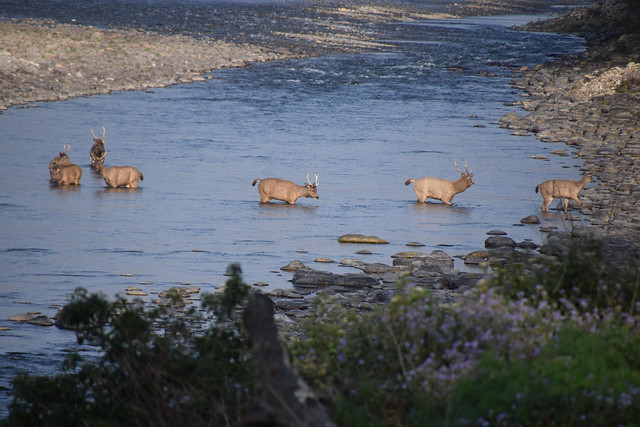A Roaring Passion for Tigers
Article body
Auburn University's affection for tigers goes far beyond its lovable Aubie. Its faculty and administrators are helping bring together wildlife researchers across the United States and India to save wild tiger populations.
The U.S. Tiger University Consortium—consisting of Auburn and Clemson along with LSU and Missouri—has garnered much exposure since its announcement in July.
Timothy and Marcia Boosinger, Auburn's provost and assistant dean of AU Libraries, respectively, traveled to India last spring to see the magnificent animals in the wild and to meet with members of the Global Tiger Forum, an international conservation group. The result was the formation of the U.S. Tiger University Consortium, an idea formulated by Clemson President James Clements.
"The people of India are very warm and welcoming," Provost Boosinger said. "They are very concerned about the loss of tiger habitat and poaching. We want to help them preserve their wild tiger populations by working with India's government and universities on research and education.
"Wild tigers are at risk if we don't plan well for the future."
Only about 3,900 wild tigers remain in 13 tiger-range countries, according to the Global Tiger Forum, which is headquartered in New Delhi, India. Two-thirds of the world's tigers live in India, where numbers have increased during the past five years thanks to anti-poaching patrols and sustainable tourism initiatives.
The Boosingers and fellow attendees visited Kanha National Park/Tiger Reserve in central India and Jim Corbett National Park in northern India, also known for wild tigers. Kanha covers 360 square miles, while Corbett covers 201 square miles.
"It was wonderful to see the tigers in their natural habitat and to meet so many scientists and researchers concerned about the issue," said Marcia Boosinger, who documented the journey with amazing photographs of wild tigers that will be used in the consortium's publications. "The tiger is revered in India and the government has very strict animal protection laws."
But even with strong laws, the problem of poaching as well as the loss of habitat still occur, says Janaki Alavalapati, dean of Auburn's School of Forestry and Wildlife Sciences and a native of India who previously worked with India's Forest Department. He has been instrumental in establishing Auburn's role in the consortium.
"The national symbol of India is the Bengal tiger, but socioeconomic pressures exist that lead to poaching. A tiger can bring $100,000 on the black market, so if a person is poor he might be tempted to kill one. We need to improve the living conditions in rural areas along with improving tiger habitat."
Myths and status symbols also play a role in poaching.
"Some people believe tiger claws bring good luck or are a status symbol in jewelry, but we believe those aspects are fading because of education," Alavalapati said. "The government tries to strictly enforce poaching laws."
On the other hand, the demand for wildlife viewing and tourism can bring both good and bad. The good is increased money flow, but tourists also cause a need for more access and, thus, reduced habitat.
"Wildlife specialists in India do a good job providing medical care, and we want to help that effort and those to balance habitat and prevent poaching," Alavalapati said. "We are implementing a multidisciplinary approach through the consortium, which will let us create a network to gather data, create better modeling and advance knowledge."
Auburn will bring two graduate students from India who will enroll in the Graduate School and work toward a doctorate in the School of Forestry and Wildlife Sciences, hopefully beginning in January 2018.
They must have a master's degree in a related field, at least two years of professional experience in conservation in India and be currently employed with a conservation agency.
The two students will collaborate with two fellow Indian graduate students who will enroll at Clemson. The four will conduct and share research on topics such as tiger population and health dynamics; human-wildlife conflicts; ecotourism and community development; habitat management; landscape ecology and planning; and policy and institutional capacity building.
"We are collaborating with several institutions in India," Alavalapati said. "The primary one is the Wildlife Institute of India, a government university. We also hope to identify another national park in southern India, and we want to grow the program to someday send our undergraduates to India for study abroad."
The Auburn and Clemson connection has another interesting aspect. Clemson Provost Robert Jones was on Auburn's forestry faculty from 1989-1995 and, in 1992, gave the first dollar toward construction of Auburn's School of Forestry and Wildlife Sciences Building. That dollar bill is framed on the foyer wall.
The two universities will celebrate the new consortium at their football game at Clemson Sept. 9. Also, the day before the game, the Global Tiger Initiative Counsel will meet with members of the U.S. Tiger University Consortium to begin implementing the new collaboration.
Related Media
Media interested in this story can contact Communications Director Preston Sparks at (334) 844-9999 or preston.sparks@auburn.edu.
Auburn University is a nationally ranked land grant institution recognized for its commitment to world-class scholarship, interdisciplinary research with an elite, top-tier Carnegie R1 classification, life-changing outreach with Carnegie’s Community Engagement designation and an undergraduate education experience second to none. Auburn is home to more than 30,000 students, and its faculty and research partners collaborate to develop and deliver meaningful scholarship, science and technology-based advancements that meet pressing regional, national and global needs. Auburn’s commitment to active student engagement, professional success and public/private partnership drives a growing reputation for outreach and extension that delivers broad economic, health and societal impact.














